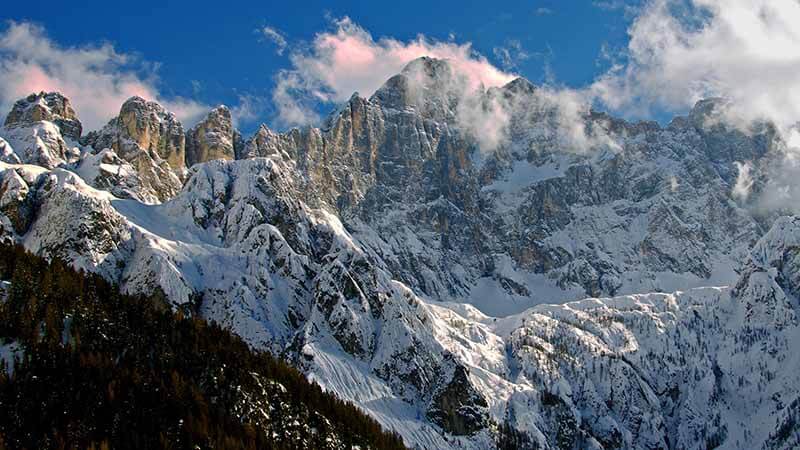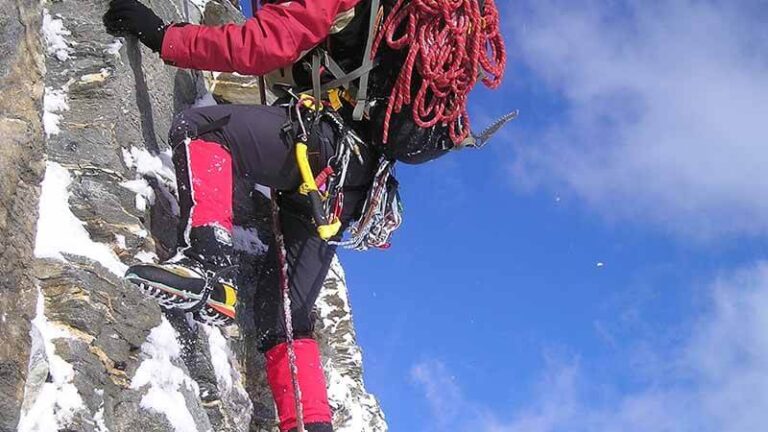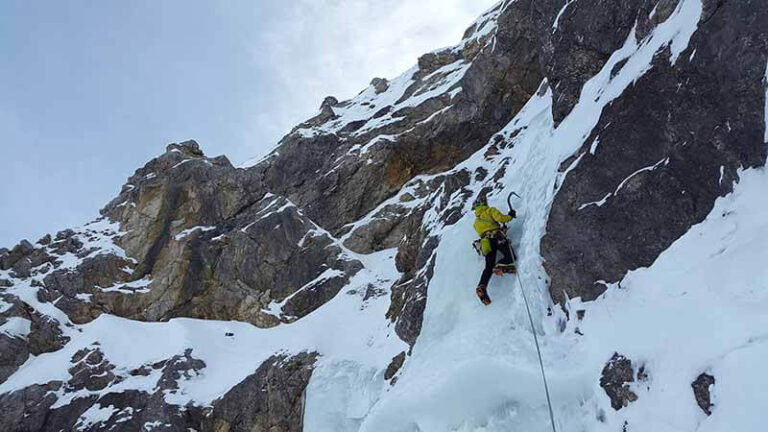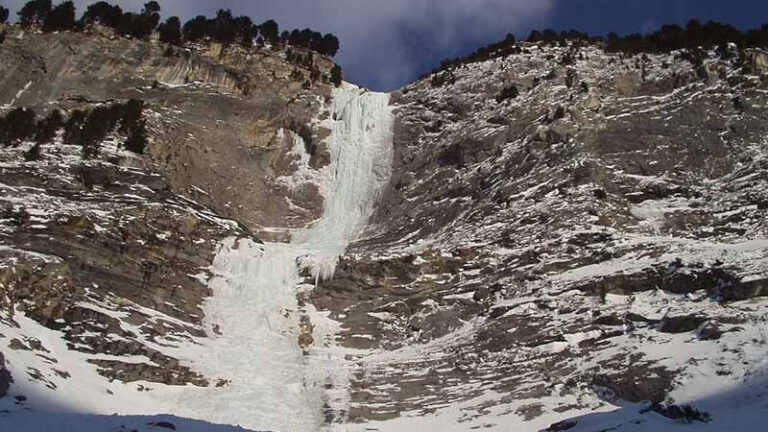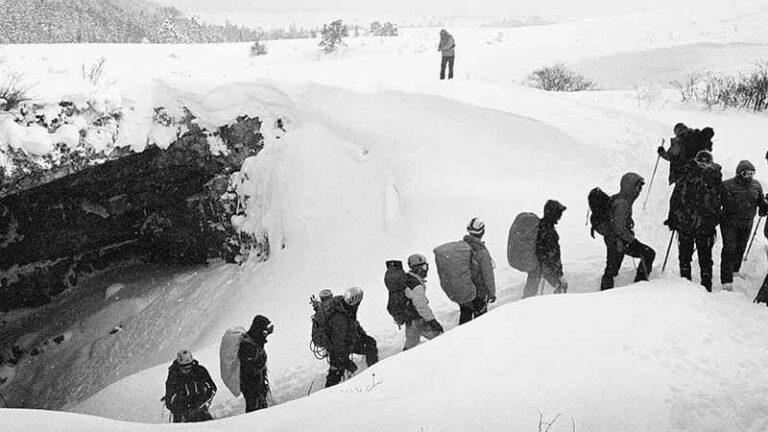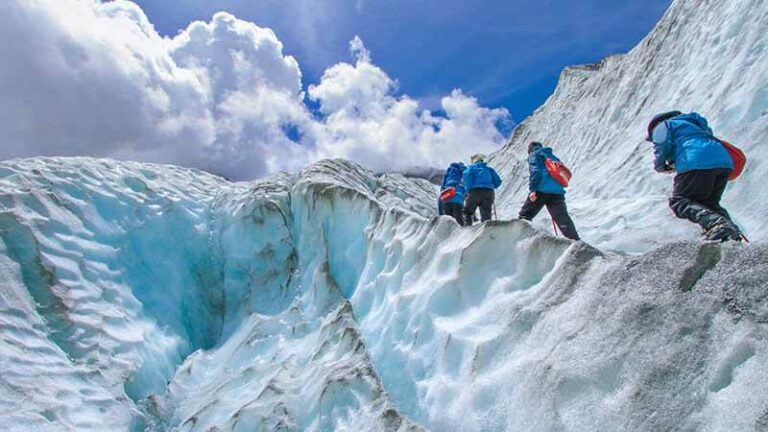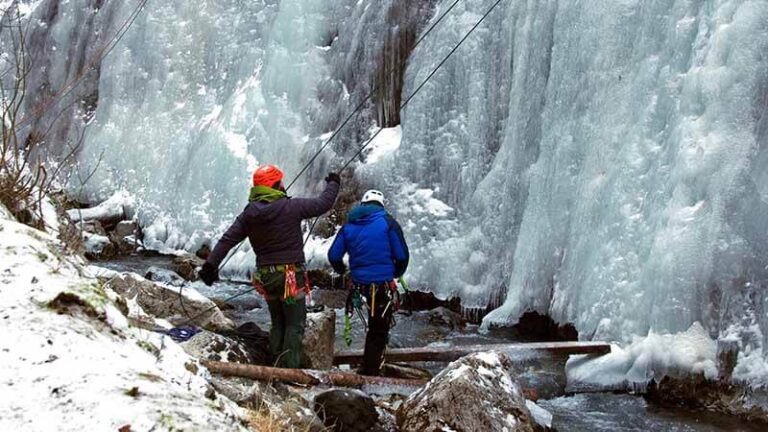What Skills Do You Need for Ice Climbing?
Ice climbing is a winter sport in which climbers use specialized equipment and tactics to ascend ice structures such as frozen waterfalls or glaciers. It necessitates a great level of physical fitness, technical expertise, and mental tenacity.
The value of ice climbing skills cannot be emphasized. Ice climbing can be extremely dangerous without adequate technique and knowledge. The chance of falling, slipping, or encountering equipment failure is significant, with serious consequences. As a result, it is critical to properly comprehend the ice climbing equipment, terrain, and techniques.
Some of the necessary skills for ice climbing include:
- Proper footwork and body alignment – learning how to utilize crampons and balance your weight on your feet in order to acquire grip and stability on the ice.
- Ice tool efficiency – mastering the use of ice axes and other specialized equipment to move along the ice surface.
- Belaying techniques – comprehending the various types of belaying systems and how to employ them to protect yourself and your partner.
- Rope management is knowing how to handle the rope safely and efficiently, including knot tying, gear clipping, and slack management.
- Risk management and decision-making – gaining the capacity to analyze the dangers of a climb, make smart judgments, and know when to back down.
Ice climbing is a difficult and rewarding activity that requires physical and mental strength. Proper training and practice are required to learn the techniques and be safe when climbing.
Physical skills needed for ice climbing
Ice climbing is a difficult and physically demanding activity that necessitates a wide range of abilities. Physical fitness and ability, among other things, are essential for ice climbers. Some of the physical abilities required for ice climbing include:
Endurance
Endurance is a necessary physical skill for ice climbing. Ice climbers must climb for long periods of time, which needs a lot of energy and stamina. To maintain balance and ascend over high ice surfaces, ice climbing needs the utilization of upper, lower, and core muscles. Long hours of climbing without appropriate endurance can result in weariness, which increases the risk of accidents and injuries.
Strength
Ice climbing necessitates a great amount of strength, particularly in the upper body and core muscles. Ice climbers must be able to grip their axes and dig their crampons into the ice, which necessitates a strong grip and arm muscles. They must also maintain their body position and balance, which needs strong core muscles. Climbers must also have strong leg muscles in order to push themselves up the ice.
Flexibility
Ice climbing requires flexibility since it allows climbers to reach and sustain unusual postures. A lack of flexibility can lead to muscle strain and injury because the sport needs a lot of bending, reaching, and twisting. Stretching before and after climbing can aid in injury prevention and flexibility improvement.
Balance
Balance is a necessary physical skill for ice climbing since it allows you to stay stable on the ice. Ice climbers must be able to redistribute their weight and keep their center of gravity stable while climbing, particularly on steep and uneven ice surfaces. A loss of balance can result in falls, which can cause significant harm.
Technical skills needed for ice climbing
Ice climbing is scaling frozen waterfalls and ice formations with particular equipment and skills. Ice climbers must have a variety of technical skills to safely navigate icy terrain and overcome difficulties in order to flourish in this demanding sport.
Knowledge of Equipment
Ice climbers must be familiar with the equipment they will be utilized, which includes ice axes, crampons, helmets, ropes, harnesses, and other protective gear. They should understand how to properly examine and maintain their equipment to ensure it is in good working order.
Proper use of Crampons and Ice Axes
Crampons are metal spikes that attach to the bottoms of climbers’ boots and provide traction and stability on the ice. While climbing, ice axes are utilized for balance and support. The proper use of these tools is critical for effective ice climbing, and climbers should be comfortable with them before attempting to climb.
Efficient Use of Body Positioning
Ice climbing necessitates an exceptional level of body control and balance. Climbers must employ efficient body alignment to move up the ice without wasting energy or risking injury. Proper body positioning entails keeping the center of gravity close to the ice, pushing forward with the legs, and maintaining a strong grasp on the ice with the crampons and ice axes.
Knot Tying and Rope Management
Ropes are frequently used for safety and to aid in climbing during ice climbing. Climbers must be able to tie and untie a variety of knots, including the figure-eight knot, double fisherman’s knot, and bowline knot. They should also know how to use the rope appropriately, including how to belay and lower a climber.
Belaying Techniques
The process of preventing a climber from falling by utilizing a rope and a belay gear is known as belaying. Ice climbers must know how to belay properly, which includes taking up and releasing slack in the rope, stopping a fall, and securely lowering a climber.
Mental skills needed for ice climbing
While physical strength, endurance, and technical expertise are important for ice climbers, they must also develop specific mental qualities in order to perform well and be safe on the ice. Here are some of the mental abilities required for ice climbing:
Focus and concentration
Climbers must pay strict attention to their body position, hand and foot placements, and the changing conditions of the ice, which requires intense focus and concentration. Even a brief lack of concentration might result in a slip, fall, or injury. As a result, ice climbers must train their minds to stay concentrated and resist distractions throughout the climb, such as fear or doubt.
Decision-making under pressure
Ice climbers frequently confront difficult and unanticipated situations that necessitate quick and effective decision-making. Even when under pressure or under stressful conditions, they must weigh the risks and rewards of several options and determine the best course of action. For example, they may have to determine whether to continue climbing or withdraw to a safer location. Making sound decisions under duress is critical for ice climbers since it can be the difference between success and failure, or even life and death.
Fear management
Fear is an understandable and reasonable reaction to the perceived danger and risk of ice climbing. Fear, on the other hand, can affect a climber’s judgment, focus, and performance. As a result, ice climbers must learn to manage their fears and turn them into a source of energy and drive rather than a hindrance. Deep breathing, visualization, positive self-talk, and exposure therapy are among the approaches that may be used.
Risk assessment and management
Ice climbing entails inherent dangers such as falling, becoming disoriented, or becoming engulfed in an avalanche. As a result, ice climbers must be able to analyze a climb’s dangers and make informed judgments about how to handle them. Checking the weather and ice conditions, utilizing suitable gear and safety equipment, and communicating effectively with their climbing partners are all part of this. They must also be prepared to react to changing conditions and take appropriate action in the event of an emergency.
Training and preparation for ice climbing
It is critical to focus on physical training activities, mental training approaches, climb planning and preparation, and skill practice on a regular basis in order to become a successful ice climber.
Physical training exercises:
Ice climbing needs a tremendous degree of strength, endurance, and flexibility, thus physical training is essential. Ice climbers can benefit from the following physical training exercises:
- Cardiovascular exercise: Exercises like jogging, cycling, and swimming are excellent for increasing endurance and stamina.
- Strength training: Exercises like weightlifting, push-ups, and pull-ups can assist increase upper body strength, which is essential for ice climbing.
- Flexibility training: Exercises like yoga or stretching can help to enhance the range of motion and prevent injuries.
- Grip strength exercises: Hanging from a bar or utilizing grip trainers can help to build grip strength, which is vital for ice climbing.
Mental training techniques:
For ice climbing, mental preparation is equally as vital as physical preparation. Ice climbers must be mentally prepared to deal with the sport’s demands and risks. Some of the mental training strategies that ice climbers can benefit from include:
- Visualization: Visualization techniques, which involve envisioning successful climbs, can assist to boost confidence and focus.
- Positive self-talk: Using positive affirmations to boost confidence and motivation is an example of positive self-talk.
- Breathing techniques: Deep breathing and meditation, for example, can assist to reduce tension and enhance attention.
- Setting goals: Setting goals can assist ice climbers stay motivated and focused on their progress.
Planning and preparation for climbs:
Because ice climbing entails many hazards and obstacles, planning and preparation are essential. Climbers should consider the following factors while planning and preparing for climbs:
- Weather: Ice climbers should be mindful of the weather and organize their climbs accordingly.
- Gear and equipment: Ice climbers should make sure they have all of the necessary gear and equipment for their climb.
- Route planning: Ice climbers should carefully plan their route, taking into account aspects like the difficulty of the climb, the length of the climb, and the location of the climb.
- Emergency plan: In the event of an accident or an unexpected incident, ice climbers should have an emergency plan in place.
Importance of practicing skills regularly:
Ice climbers should practice their skills on a regular basis to enhance muscle memory and technique. Ice climbers should constantly practice the following skills:
- Ice axe techniques: Ice climbers should practice using their ice axes to ensure that their technique is comfortable and competent.
- Crampon techniques: Ice climbers should practice using crampons to ensure that their technique is comfortable and confident.
- Rope management: To guarantee that rope management methods such as tying knots and belaying are safe and effective, ice climbers should practice them.
- Movement skills: To improve technique and efficiency, ice climbers should practice movement skills such as balance, footwork, and body posture.
Conclusion
Ice climbing is a demanding and rewarding sport that demands commitment and effort to perfect. If you’re just getting started, don’t be discouraged if development is sluggish or you struggle at first. Continue to push yourself to improve and look for opportunities to learn from more experienced climbers. Remember that every modest accomplishment is a step closer to becoming an expert ice climber.
While ice climbing can be exhilarating and satisfying, safety should always come first. This includes thoroughly checking the weather and ice conditions prior to each climb, wearing suitable safety equipment, employing proper tactics and equipment, and being prepared for emergencies. Accidents can happen even to expert climbers, so always err on the side of caution and take precautions to reduce hazards. You may enjoy the thrill of ice climbing while reducing your chances of damage or mishap by being cautious about safety.

